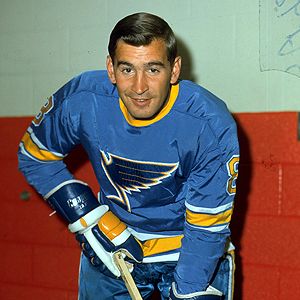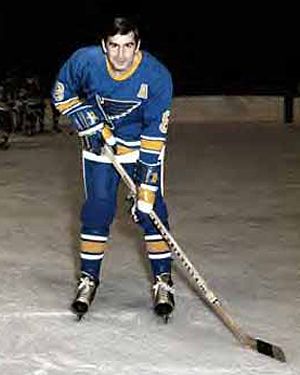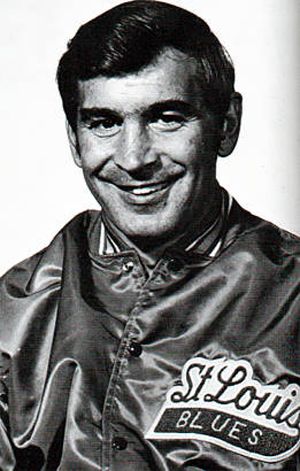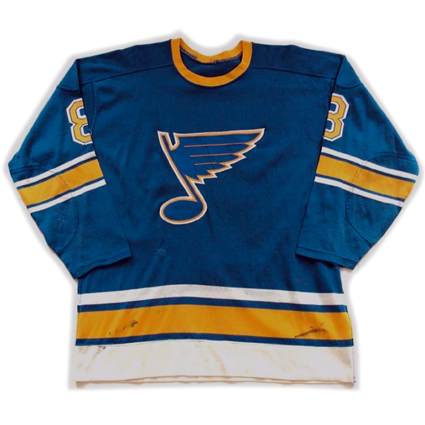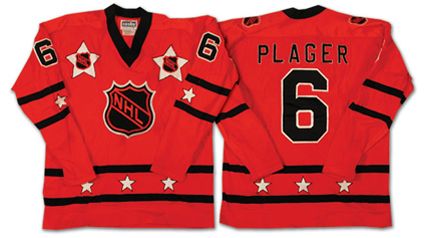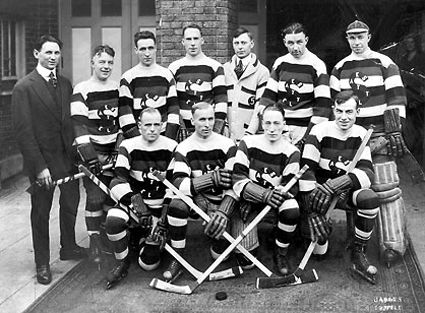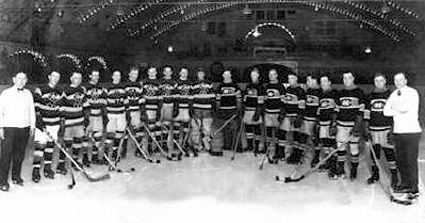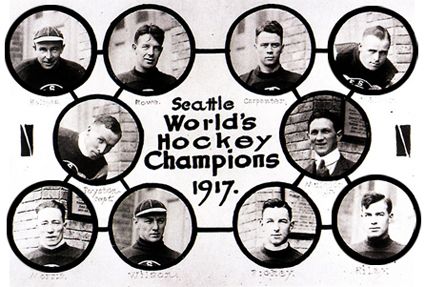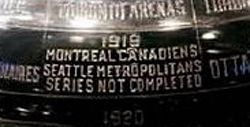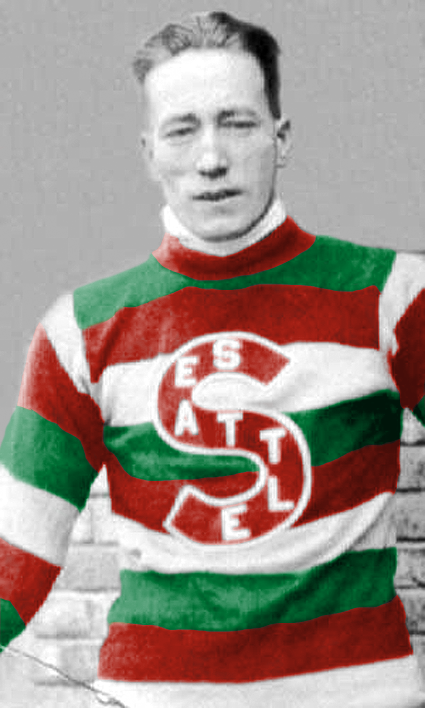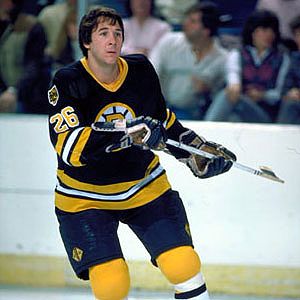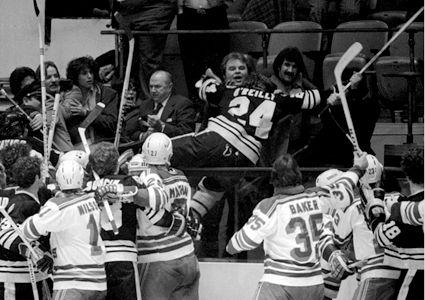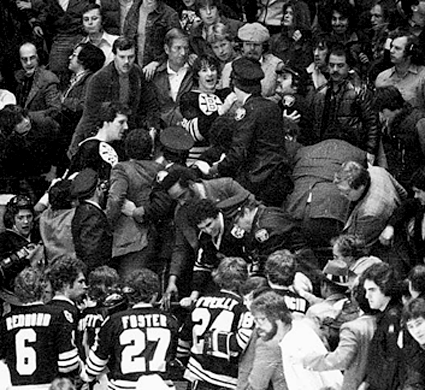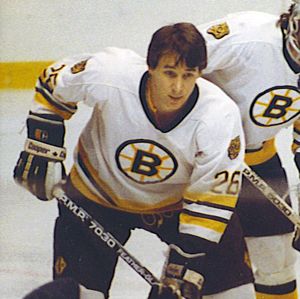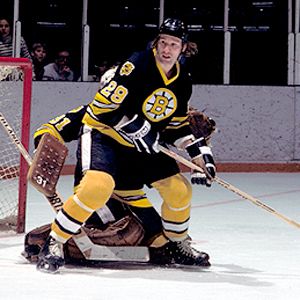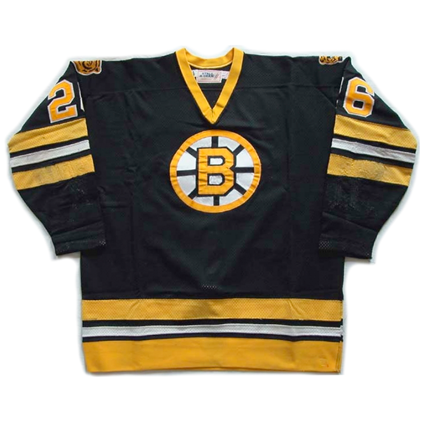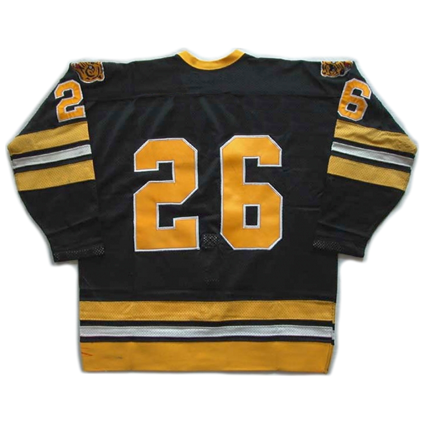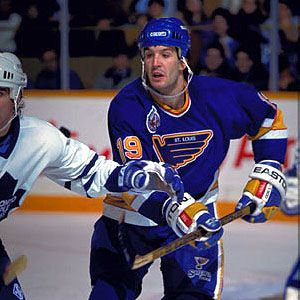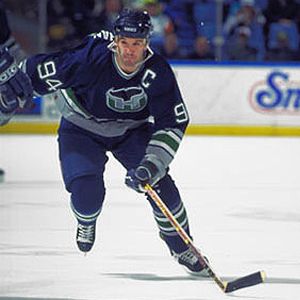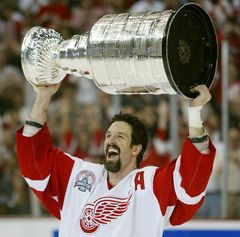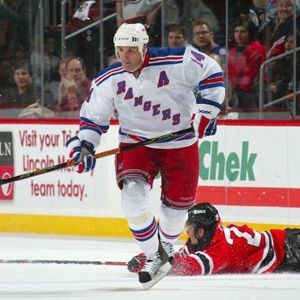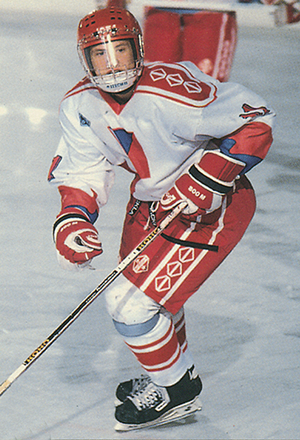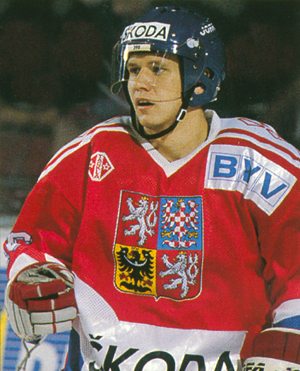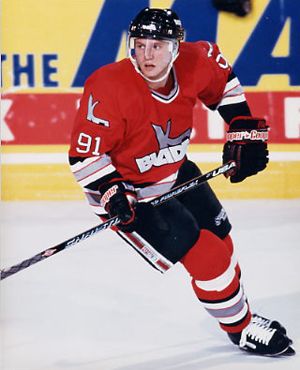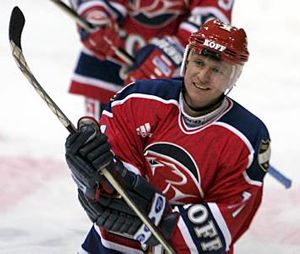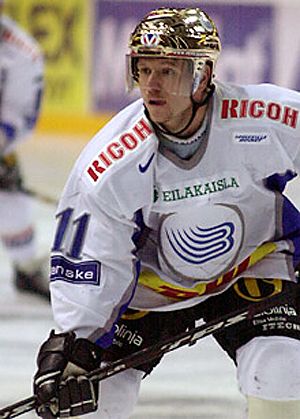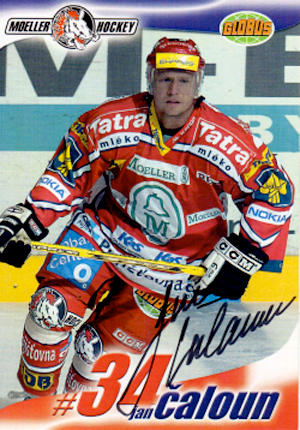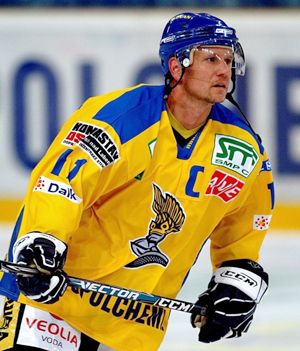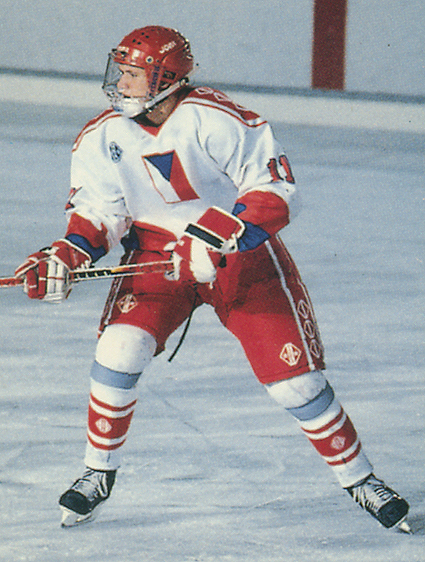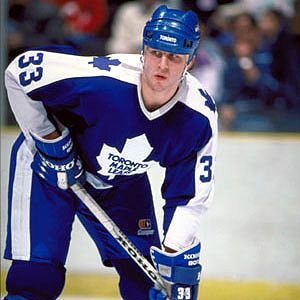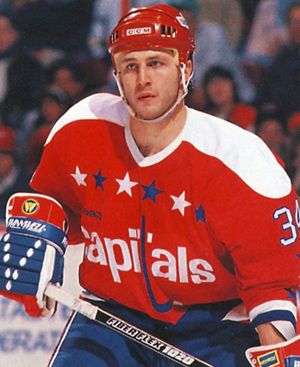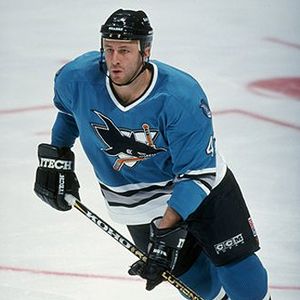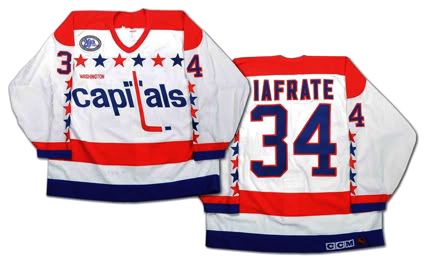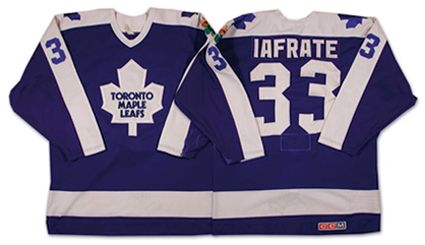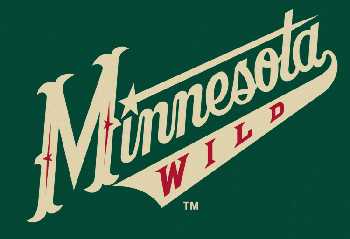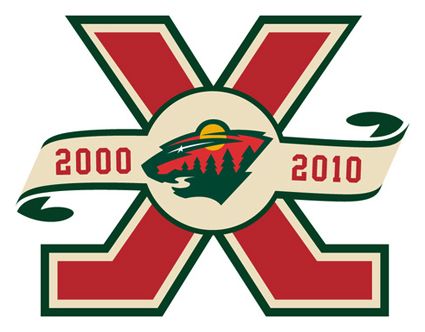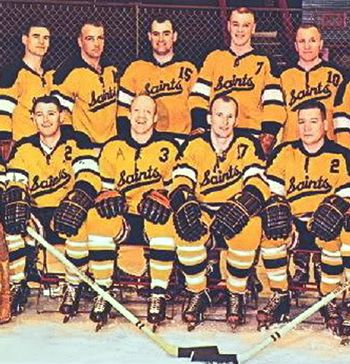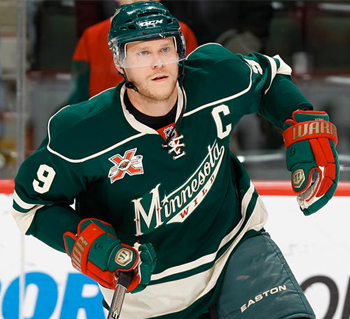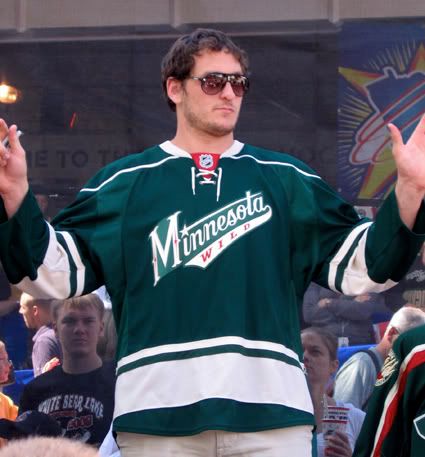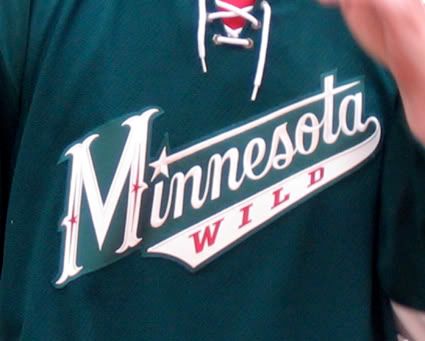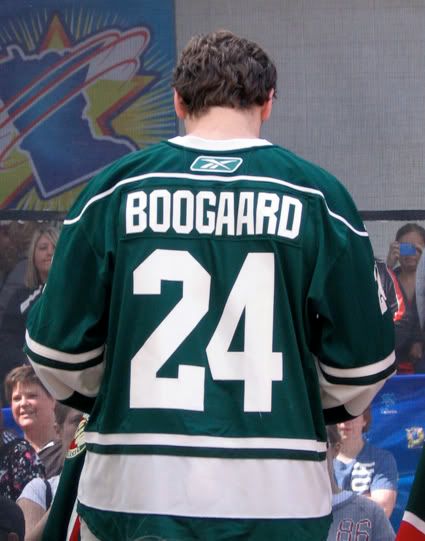Saturday, March 26, 2011
1968-69 St. Louis Blues Barclay Plager Jersey
One of the most popular players in St. Louis Blues history, Barclay Plager was born on this date in 1941. Barclay was the oldest of the three Plager brother to play in the NHL, followed by Bill and Bob.
Barclay began his road to the NHL playing for the Peterborough Petes on the Ontario Hockey Association in 1957-58. During his four seasons playing for the Petes, Barclay established a himself as a rugged, tough defenseman, a reputation only enhanced by a fight he had with his brother Bob, who was playing for the Guelph Royals.
Barclay, accidentally he claimed, jammed his stick in Bob's mouth and Bob responded with his fists. "We went at it pretty good on the ice," Bob remembers, "but they broke it up. As we went into the penalty box he gave me a shove and we started fighting again. Then, after we were thrown out of the game, we continued to battle in the runway leading to the dressing rooms. But I got the best of him for the first time. Afterwards I met him in a restaurant across the street from the rink. I was sitting there eating when he walked in. We looked at each other and I didn't know what was going to happen. The whole Guelph team rushed into the place to see. Everyone figured we'd go at it again, but Barclay just looked me in the eye and said, 'Can you lend me five dollars?'"
Like many players of his era, Plager found himself mired in the minor leagues, unable to crack the exclusive ranks of the NHL, which was then only six member clubs which afforded approximately 30 jobs to defensemen league wide.
Plager began his travels through the minor leagues with a stop in Hull in 1961-62, Edmonton and Pittsburgh in 1962-63, Omaha in 1963-64, where he had an outstanding season with 75 points where he led the league in both assists and penalty minutes by wide margins as Omaha captured the CPHL's inaugural Adams Cup, and Springfield in 1964-65 and 1965-66 before splitting time between Springfield and Omaha in 1966-67.
Just when it looked as if Plager would toil in the minors for the remainder of his playing days, the NHL expansion of 1967-68 doubled the size of the league overnight, creating twice as many job opportunities than previously available.
With his rights acquired by the St. Louis Blues from the New York Rangers, Plager embarked on a new phase of his career in the NHL. While the Blues finished third in the "Western" division, comprised of the six new expansion clubs, they outlasted both the Philadelphia Flyers and Minnesota North Stars to qualify for the Stanley Cup Finals in only their first season in the NHL. Although Plager only played in 49 of the Blues games due to spending 20 games with the Buffalo Bisons of the AHL, Plager's no nonsense approach to his game led to a league leading 153 penalty minutes. Barclay was also joined on the Blues blueline by his brother Bob who arrived via a trade with the Rangers.
In 1968-69, backed by veteran goaltenders Glenn Hall and Jacques Plante, Plager and the Blues defensive corps of Al Arbour, Jean-Guy Talbot, veteran Doug Harvey, Noel Picard, Jim Roberts, Bob Plager, Terry Crisp and Ron Schock shockingly allowed the least goals against by a country mile, 39 less than the New York Rangers and 68 less an any of their expansion cousins to win the Vezina Trophy for Hall and Plante.
"We did anything to protect the goaltender," recalled Bob Plager. "The greatest time for us was the year we won the Vezina Trophy. Glenn Hall and Jacques Plante were in goal and we only allowed 157 goals. That record will probably never be broken. Winning the Vezina was the finest reward anyone could get."
Of note, Bill Plager arrived in St. Louis for a pair of games, giving St. Louis all three brothers at the same time.
Barclay, Bill and Bob Plager lacing up their skates for the Blues
The Blues again returned to the Stanley Cup Finals after eliminating the Flyers and Los Angeles Kings.
The Blues were again stingy on defense, coming in second to Boston but 46 goals better than any other "Second 6" franchise and again made their annual trip to the finals, but once again they were swept by an Original 6 franchise. Barclay led the Blues in trips to the penalty box that season, besting his brother Bob 128 penalty minutes to 113.
Barclay, Bob and Bill would play for the Blues during parts of three seasons, with the limiting factor being mainly Bill's number of games played, as he had 2 in 1968-69, 24 in 1969-70 and 36 during his final season with the Blues in 1970-71 before moving on to the Atlanta Flames and considerably more playing time.
For the next six seasons, Barclay would continue to provide his rock-steady defensive play and offensive output, as he would play no less than 54 games while scoring between 26 and 33 points, which was Plager's NHL career high. Additionally, he was named team captain in 1972, a position he would hold until 1976.
After one more season in St. Louis, Barclay would play just two final games for the Blues before being named as a player/coach for the Kansas City Blues in 19767-77. He remained an effective player and as well as a team leader, as coach Plager guided his team to the CHL finals, while Plager the player was named as the league's MVP.
He served the same dual roles in 1977-78 with the Salt Lake Golden Eagles, which would prove to be his final season as an active player.
He remained with the Blues organization as a scout and an assistant coach before being named the club's head coach for the 1978-79 season.
His number 8 was retired by the Blues on March 24, 1981.
Plager's final NHL stats were 44 goals and 187 assists for 231 points along with 1,115 penalty minutes, which included leading the team on four separate occasions, and 15 broken noses, a testament to his bruising, shot blocking ways which earned him the hearts of the fans.
Today's featured jersey is a 1968-69 St. Louis Blues Barclay Plager jersey as worn by the Blues during their second ever season, one in which they would make it all the way to the Stanley Cup Finals.
This jersey style, introduced during the Blues first season of 1967-68, would remain in use through 1972-73 when the colors of the striping were reversed, with names arriving on the back in 1977-78. That similar style would survive through the 1978-79 season when additional trim was added to the shoulder yoke, keeping it in line with the striping on the shoulders of the white jerseys.
Bonus Jersey: Today's bonus jersey is a 1973 NHL All-Star Game Barclay Plager jersey. Plager played in the NHL All-Star Game on four occasions, 1970, 1971, 1973 and 1974. This particular jersey was worn by Barclay Plager during the 1973 edition held in New York's Madison Square Garden.
This was the first year for this brand new style of All-Star jersey and it would be worn for eight All-Star Games through 1981, skipping 1979 when a slightly different jersey was worn for the Challenge Cup against the Soviet Union instead of the normal all-star game format.
Today's video selection features the Plager brothers, Barclay, Bob and Bill.
Labels:
Plager Barclay,
St. Louis Blues
Thursday, March 24, 2011
1916-17 Seattle Metropolitans Bernie Morris Jersey
The Pacific Coast Hockey League was founded in 1911 by Frank and Lester Patrick. After three seasons the league expanded into the United States for the first time with the addition of the Portland Rosebuds, who were joined the following season by the Seattle Metropolitans.
The Metropolitans finished third in the four team league with a 9-9 record. They were led in scoring by Bernie Morris, who scored 23 goals and 9 assists in the 18 game schedule while Harry "Hap" Holmes held down the goaltending duties.
During the Metropolitans second season, Morris again led the club in scoring with a stellar 37 goals and 17 assists for 54 points in 24 games to lead the league in scoring as Seattle edged the Vancouver Millionaires to the regular season title with a 16-8 record. Additionally, Holmes led all goalkeepers that season with a 3.3o goals against average, well over a goal better than his next closest competition.
Unlike the Eastern National Hockey Association, which held a post season playoff to determine the league champion, Seattle advanced to the Stanley Cup Final simply by virtue of finishing first.
The 1917 Stanley Cup finalists, the Seattle Metropolitans and the Montreal Canadiens
The Metropolitans hosted the defending cup holders, the Montreal Canadiens, in a best of five series at the Seattle Ice Arena. The Canadiens defeated Seattle 8-4 in Game 1 held under PCHA rules as Didier Pitre scored four times for Montreal.
Game 2, held under NHA rules, saw the Metropolitans even the series with a dominant 6-1 win. Alternating back to PCHA rules, Seattle and Holmes again held Montreal to a single goal while Seattle scored 4 to take a 2-1 series lead.
Held on this date in 1917, Game 3 was all Seattle. Morris alone outscored Montreal, and by a wide margin, as he scored 6 of the Metropolitans goals as they won going away by a score of 9-1 to become the first team based in the United States to win the Stanley Cup in it's 24 year history. During the series Morris would account for 14 of Seattle's 23 goals.
The following season the Metropolitans would finish first overall during the regular season with an 11-7 record, but would lose their hold on the Stanley Cup when they were defeated in the newly instituted PCHA playoffs.
They turned the tables in 1918-19 by defeating the Millionaires to advance to the 1919 finals. Tragically, after the series with the Canadiens was tied at 2-2-1, several of the players from Montreal fell ill with the Spanish Influenza, which caused the cancellation of the remainder of the series and would claim the life of Montreal's Joe Hall.
The 1919 Stanley Cup engraving
The 1919-20 PCHA season was extraordinarily tight, with the Metropolitans finishing first with a 12-10 record to the Millionaires 11-11 and the Victoria Aristocrats 10-12. Seattle again won the PCHA playoff and qualified for the Stanley Cup Finals for the third time in four years, but came up short in five games against the Ottawa Senators.
Seattle finished with a 12-11-1 record in 1920-21 and missed out on a chance to return to the Stanley Cup Finals with a loss in the PCHA playoff. Parity again reigned in 1921-22 as Seattle finished first at 12-11-1 over the Millionaires at 12-12 and Victoria just behind at 11-12-1.
With games against teams from the Western Canada Hockey League counting in the PCHA standings, the Metropolitans finished last in the league despite a .500 record of 15-15.
The same system was in place for the 1923-24 season, and with the WCHL teams having improved since the previous season, Seattle oddly finished with the first losing record in franchise history at 14-16, yet finished first overall in the PCHA, ahead of Vancouver's 13-16-1 mark.
Seattle lost the two-game, total-goals playoff with Vancouver 4-3, which would turn out to be the final game for the Metropolitans, as the Seattle Ice Arena owners did not renew the team's lease, which led to the club ceasing operations, which in turn brought a close to the PCHA.
During their nine year run, Frank Foyston would lead the club in scoring with 139 goals and 163 points, followed by Morris with 139 points. Holmes would lead the PCHA in goaltending five times in the six years he was a member of the Metropolitans, including four in a row from 1918-19 to 1921-22.
Today's featured jersey is a 1916-17 Seattle Metropolitans Bernie Morris jersey as worn when he scored six goals in the Metropolitans Stanley Cup clinching goal on this date in 1917.
The Metropolitans would wear a barberpole style jersey throughout their history with minor variations to their "S" crest until 1921, when the word "Seattle" diagonally across the chest.
Morris first played for a number of senior level teams prior to joining the Victoria Aristocrats of the PCHA in 1914-15. He then joined Seattle for eight years. In 1923-24 he was traded to the Calgary Tigers of the WCHL and played there for a season and a half before moving east to become a member of the brand new Boston Bruins of the NHL for six games. After being released by the Bruins, Morris returned to the WCHL and became a member of the Regina Capitals. He played the final five seasons of his hockey career with a variety of teams in a series of minor leagues.
Labels:
Morris Bernie,
Seattle Metropolitans
1976-77 Boston Bruins Mike Milbury Jersey
After playing for three seasons for the Colgate Red Raiders of the ECAC, defenseman Mike Milbury was an undrafted free agent who signed with his hometown team, the Boston Bruins.
While with Colgate, Milbury played a total of 76 games and scored 6 goals and 55 assists while amassing 203 penalty minutes while leading Colgate in penalties in both 1973 and 1974.
The Bruins assigned Milbury to their top minor league affiliate, the Rochester Americans for the 1974-75 season. There he continued his rugged ways, only now free from the restraints of the rules of NCAA college hockey and allowed to drop the gloves at will. 246 penalty minutes later, Milbury led the Americans in penalty minutes while having the fourth most in the AHL.
During his second season in Rochester, this time with a somewhat more restrained 199 penalty minutes, Milbury made his NHL debut with three games with the Bruins prior to appearing in 11 playoff games for Boston.
The following season Milbury was now a full time Bruin. He scored his first NHL goal on his way to 6 that season, as well as a total of 24 points. It was on this date however, that Milbury broke a 50 year old Bruins record when he was whistled for a major and a misconduct, which gave him 166 penalty minutes for the season, breaking a record held by Eddie Shore since 1927.
The 1977-78 season saw Milbury establish a career high in points with 8 goals and 30 assists for 38 points as well as 151 minutes in the penalty box. He would add another 9 points during the playoffs, also a career high, as the Bruins returned to the Stanley Cup Finals for the second year in a row.
The 1978-79 season was one of consistency, as Milbury posted nearly identical numbers as the year before, with 35 points and 149 penalty minutes. His season, if not his career, would be remembered for once incident however, as Milbury was captured by the TV cameras entering the stands at Madison Square Garden on December 23, 1979 after teammate Terry O'Reilly scaled the glass and entered the stands in pursuit of a New York Rangers fan, who had taken the Bruins' Stan Jonathan's stick and clouted him with it during a postgame scrum next to the glass, which was much lower those days than it is now.
Milbury, having already made his way back to the Bruins dressing room, heard of the fracas and rushed to the scene in the stands, where he saw none other than Peter McNab (who totaled just 4 penalty minutes the previous season!) fully engaged with a fan who had been hitting O'Reilly while O'Reilly was fighting with his brother.
Claiming the fan had kicked him, Milbury tore off the fan's shoe and proceeded to beat him with it, clearly taking the approach of "act first, ask questions later". Milbury was later fined $500 and suspended for six games for his part in the incident.
Perhaps chagrined by the entire incident at Madison Square Garden, Milbury set a career high in goals with 10 in 1979-80 and was called for a mere 59 minutes in penalties, 90 minutes less than the year before and easily the lowest amount of his career. During the playoffs however, Milbury nearly equalled his season total with 50 minutes in just 10 games.
The Milbury of old returned in 1980-81 with a vengeance, as he set a career high with 222 minutes, one shy of O'Reilly's team leading 223.
He was limited to just 51 games in 1981-82, ending a streak of seven professional seasons with 71 games or more. He was back to his usual 78 games played the following season, racking up 9 goals and 216 penalty minutes to easily lead the Bruins with more than double any of his teammates. The Bruins missed the playoffs that season for the only time in Milbury's 12 years with the Bruins.
He would play four more seasons with Boston before retiring, leading the Bruins in penalty minutes once more in 1983-84.
His final NHL totals were 754 games played, 49 goals and 189 assists for 238 points. His final penalty minute total stands at 1,552, second all time behind only teammate O'Reilly.
Today's featured jersey is a 1976-77 Boston Bruins Mike Milbury jersey, as worn during Milbury's record breaking rookie season when he broke Eddie Shore's 50 year old mark.
The Bruins adopted this style jersey in 1974-75 when the removed the shoulder yoke from thier previous jerseys. In 1976-77, the bear head logos appeared on the shoulders for the first time and names on the back arrived permanently the following year. While there were some changes in the font used for the numbers over time, this style would remain in use all the way through the 1994-95 season.
In today's video segment, Milbury recounts his involvement in the fracas in Madison Square Garden in 1979 with the benefit of many years time to refine his story.
Labels:
Boston Bruins,
Milbury Mike
Wednesday, March 23, 2011
1997-98 Detroit Red Wings Brendan Shanahan Jersey
Brendan Shanahan played his junior hockey with the London Knights of the OHL in 1985-85 and 1986-87 prior to being drafted second overall by the New Jersey Devils in the 1987 NHL Entry Draft.
Shanahan while captain of the London Knights in 1986-87. Note the Cooperalls!
He scored 7 goals during his first season and more than tripled that to 22 during his second. 1989-90 saw him reach the 30 goal mark for the first time, as well as recording 42 assists for 72 points in 73 games. During his final season with the Devils, Shanahan just missed the 30 goal mark with 29.
He signed with the St. Louis Blues for the 1991-92 season as a free agent and once more reached the 30 goal mark with 33. Following the conclusion of his fifth season in the NHL, Shanahan was averaging 24 goals, 32 assists and 139 penalty minutes a season, making him a threat for a Gordie Howe Hat Trick each and every night with his goal scoring capabilities, playmaking skills and tough and rugged style.
His offensive game would reach another level during the 1992-93 season when Shanahan would become the 69th player in NHL history to record a 50 goal season when he totaled 51 goals. His 43 assists gave him a then career high of 94 points, all while topping his highest penalty minute total with 174.
Shanahan would set career highs across the board in 1993-94 when he scored 52 goals and 50 assists for his only 100 point season with 102 to lead the Blues in scoring, which did not happen often with sniper Brett Hull on the roster. Additionally, he topped 200 penalty minutes in the process with 211 for the season, also a career high.
After briefly playing in Germany during the NHL lockout of 1994, Shanahan returned to St. Louis to score 41 points in 45 games to close out his time in St. Louis.
Shanahan was then dealt to the Hartford Whalers for the 1995-96 season, where he led the club in goals with 44 and points with 78 while serving as the team captain.
Unhappy with the situation in Hartford, Shanahan asked to be traded, a request which was granted two games into the 1996-97 season, which sent him to the Detroit Red Wings, a move which would pay immediate dividends.
The Red Wings had been a team on the rise with the arrival of head coach Scotty Bowman in 1993. The Red Wings kept adding vital pieces and solid role players and reached the Stanley Cup Finals first in 1995. After losing in the conference finals in 1996, Shananan's arrival early in the 1996-97 season had an immediate impact on the team, as he led the club in scoring with 46 goals and 87 points and provided another gritty player to a lineup filled with rough, hard hitting players. After besting rivals the Colorado Avalanche in the conference finals, the Red Wings easily swept the Philadelphia Flyers in four straight for Shanahan's first Stanley Cup championship as well as the Red Wings first since 1955.
Shanahan's point total decreased by 30 points the following season as the NHL entered a new, more defensive era, leaving the days of 150 point scorers in the rear view mirror. For the remainder of his career, Shanahan would only top 80 points once more and never again reach the 46 goals he scored in 1996-97. Still, he remained a consistent, tough as nails two way player who remained in the top for in scoring annually for Detroit.
After scoring 28 goals in 1997-98, as the Red Wings repeated as Stanley Cup champions, Shanahan reeled of five consecutive 30 goal seasons, including a high of 41 in 1999-00. He led the Red Wings in scoring in both 2000-01 and 2001-02, which included his 500th career goal on this date in 2002, making him the 30th player in the history of the NHL to achieve that lofty status, which he did with the game winning goal in a 2-0 win over heated rivals the Avalanche and Hall of Fame Goaltender Patrick Roy in his 1,100th game.
Even better, Shanahan also recored his 1,00oth career point that season and Detroit capped off the campaign with their, and Shanahan's, third Stanley Cup championship in six seasons when they defeated the Carolina Hurricanes in five games.
Following that championship, Shanahan would play three more seasons with Detroit, including a 40 goal, 81 point 2005-06 season, his final year in Detroit, prior to moving on to the New York Rangers as a free agent for two seasons.
He returned to where it all started when he signed with New Jersey for the second half of the 2008-09 season after sitting out the first three months of the season. During the second half of the season, he would play the final 34 games of his career before retiring just prior to the 2009-10 season.
His final career NHL totals are 1,524 games played with 656 goals and 698 assists for 1,354 points and 2,489 penalty minutes, three Stanley Cups and what is believed to be a record 17 Gordie Howe Hat Tricks.
Today's featured jersey is a 1997-98 Detroit Red Wings Brendan Shanahan jersey as worn during the Super Skills Competition at the 1998 NHL All-Star Game in Vancouver. The 1998 NHL All-Star Game was the first to feature the World vs. North America format to promote the participation of the best NHL players in the upcoming Olympics in Nagano, Japan.
For the Super Skills Competition, each player wore their regular club team jerseys only with the addition of a patch from each player's country of origin to tie into the theme of the World vs. North America format for the following day's All-Star Game.
While the World vs. North America format would continue for four more years, 1998 would be the only occasion that the flags would be added to the player's club team jerseys for the Super Skills Competition.
Shanahan, and teammates Slava Fetisov, Igor Larionov and Nicklas Lidstrom, who all wore white Red Wings jerseys for the World team, had the flags placed above the "Believe" patch worn in support of teammate Vladimir Konstantinov and team masseur Sergei Mnatsakanov who were seriously injured in a limousine crash in the days following their 1997 Stanley Cup championship.
During the competition, Shanahan would tie for the win in the Accuracy Shooting contest with Ray Bourque and Peter Forsberg hitting all four targets in six shots while wearing today's featured jersey.
Today's video section begins with a well done tribute to Shanahan, which highlights various eras and aspects of his game.
While he was a fearsome competitor on the ice, he had a great sense of humor off the ice, evidenced by the following.
Here footage of Shanahan's first NHL goal, scored while with the Devils.
Fast forward to goal #500, scored on this date in 2002.
For more on Shanahan, we recommend the following profile on Shananan from the MSG Network in four parts.
Labels:
Detroit Red Wings,
Shanahan Brendan
Tuesday, March 22, 2011
1992 Czechoslovakia Jan Caloun Jersey
Jan Caloun was an offensive talent from Czechoslovakia who first made a name for himself at the European Junior Championships in 1990 with 7 points in 6 games. He then graduated from the HC Litvinov junior team to the senior club, which participated in the Czech Extraliga.
As a 19 year old, Caloun he impressed with 28 goals and 47 points in 50 games. The next season he was limited to 37 games, but averaged a point per game with 32 goals and 37 assists. During the postseason, he contributed 13 points in 9 games. He was also a member of the Czechoslovakia National Team at the 1992 World Junior Tournament where he scored 8 of the Czech's 28 goals in 7 games to lead the tournament in goals.
Following the season, Caloun was selected 75th overall by the San Jose Sharks in the 1992 NHL Entry Draft.
He remained with HC Litvinov for two more seasons, scoring 44 goals and 67 points in 47 games in 1992-93 to lead the team in scoring and the league in goals at the age of 21. He also made his debut at the World Championships that year, earning a bronze medal playing for the newly formed Czech Republic, which had separated itself from Slovakia on January 1st of 1993.
After one final season with Litvinov, still averaging more than a point per game with 42 in 38 games, Caloun came to North America and was assigned to the Kansas City Blades of the IHL. There he picked right up where he left off in Europe, scoring 34 goals and 39 assists for 73 points in 76 games to lead the Blades in scoring as a rookie.
Bizarrely, despite finishing 16th out of 17 IHL clubs, the Blades qualified for the playoffs with 76 points, 44 points behind the league leading Denver Grizzlies, with only the Indianapolis Ice with 72 points failing to qualify for the postseason.
The Blades opened the playoffs against the 4th place Detroit Vipers and stunned them with a 4-3 win in Detroit during the decisive Game 5 of their opening round series. Next up for the Blades was the 3rd place Peoria Rivermen, whom they dispatched in 5 games.
The 4th place Kalamazoo Wings were up next, and once more the feisty Blades eliminated a club who finished much higher than them in the standings, this time with an easy 7-3 win in Game 7 on the road once more to advance to the Turner Cup Finals where their Cinderella run finally came to and end to the 1st place Denver Grizzlies. During their 21 playoff games, Caloun came second in team scoring with 13 goals and 23 points.
He returned to Kansas City for another season in 1995-96 and topped his goal total from the year before, with 38 goals in 15 less games, as Caloun was called up by the Sharks on March 18th for their game against the Boston Bruins. It was a memorable debut for Caloun that evening, as he scored on his first shot on goal in the NHL with an important goal, on the power play no less. The goal was the Sharks second of the game after spotting the Bruins a 3-0 lead before coming back to eventually tie the game 3-3.
Two nights later the dream start to Caloun's career continued when he scored his second NHL goal at 2:11 of the second period in his first shot of the game to give the Sharks a 3-0 lead over the Winnipeg Jets. At exactly the same 2:11 mark of the third period, Caloun remarkably scored on his next shot of the game, giving him 3 goals on 3 shots since being called up. The Sharks eventually won the game 7-1 over the Jets.
The Sharks next game came on this date in 1996 versus the Calgary Flames on the road. After the Flames scored first, Caloun's remarkable start continued, when the NHL rookie scored 7:23 remaining in the third period on a one-timer to tie the game on Caloun's first shot of the game, giving him an incredible 4 goals on the first 4 shots of his NHL career! The streak would later end, as his second shot on goal of the game was saved by Calgary's Rick Tabaracci. The Sharks eventually won the game in overtime thanks to Caloun's equalizer.
Caloun would eventually score a noteworthy 8 goals in 11 games for the Sharks that season. Despite that initial promise, Caloun was assigned to the Kentucky Thorougblades of the AHL for 1996-97 and led the club with 86 points in 66 games, 26 more than his next closest teammate. Caloun was also called up for a pair of games with the Sharks that season but could not duplicate his amazing offensive production of the year prior.
With the handwriting on the wall concerning his future with the Sharks, Caloun signed to play with HIFK Helsinki of the Finnish SM-Liiga for 1997-98 where he led the club in scoring with 48 points, good for third overall in the league. He would go on to lead the league in playoff scoring with 17 points in nine games as HIFK captured the league playoff championship.
In February, Caloun was a member of the Czech Republic Olympic Team which captured the gold medal in Nagano, Japan, the first Olympics which featured NHL players.
Caloun, simply tore up the SM-Liiga following season, amassing 81 points in just 51 games to lead the league in scoring by a full 23 points over his next closest challenger. He repeated as the top scorer in the playoffs as HIFK again returned to the finals.
Following the Finnish season, Caloun participated in his second World Championships and contributed 4 goals in 6 games as the Czechs captured the gold medal as tournament champions.
In 1999-00 Caloun led HIFK in scoring for the third consecutive season. His 72 points in 44 games placed him second in the league scoring race.
He returned to North America at the start of 2000-01, where he joined the expansion Columbus Blue Jackets of the newly expanded NHL, which created roughly 50 new jobs for players with the addition of Columbus and Minnesota. In 11 games, Caloun scored three assists before securing his release, which allowed him to rejoin HIFK in time to play 24 games that season.
For 2001-02, he joined the Espoo Blues for the next three seasons, leading the Blues in scoring all three seasons and the entire league in 2002-03 for his second SM-Liiga scoring title.
His 2004-05 season was an unsettled one, as he competed for four different clubs, Severstal Cherepovets (5 games) and Sibir Nobosibirsk (1 game) of the Russian Hockey League and a return to familiar territory with HC Litvinov (24 games and 39 points) and Slovan HC of the Czech second division for a pair of games. His next home was HC Pardubice of the Czech Extraliga. In 2005-06 he led Pardubice in scoring with 39 points in 48 games.
After one more season with Pardubice he rejoined Slovan HC for the next two seasons, the first of which was in the Extraliga and the second one down in the second level after being relegated.
For 2009-10, Caloun remained in the Czech second division with HC Vrchlabi and scored 13 goals and 27 points before he retired as a player after 19 seasons, 940 games, 515 goals and 499 assists for 1,014 points at all levels combined.
Today's featured jersey is a 1992 Czechoslovakia National Team Jan Caloun jersey from the final year of participation by Czechoslovakia in international hockey prior to dividing into the Czech Republic and Slovakia with the start of 1993.
This jersey is made by Tackla and features the familiar Tackla diamond shapes on the shoulders. Tackla a made jerseys for the member clubs of the IIHF in international tournaments from 1988 through 1995, although the final two years they were branded with large Reebok logos on the shoulders.
Today's video section begins with Caloun's return to HIFK after leaving the Blue Jackets and returning to Finland.
This next interview with Caloun, a Czech being interviewed by a Finn, is conducted conveniently in English.
Labels:
Caloun Jan,
Czechoslovakia
Monday, March 21, 2011
1993-94 Washington Capitals Al Iafrate Jersey
Known for his powerful slapshot, Al Iafrate was born on this date in 1966 in Michigan. During the 1983-84 season, Iafrate played 61 games for the United States National Team, which included competing at the 1984 Olympics in Sarajevo, Yugoslavia. Following the Olympics, Iafrate finished the season with the Belleville Bulls of the OHL prior to being drafted 4th overall by the Toronto Maple Leafs that spring., making him the first US born player ever selected by the Maple Leafs in the first round.
Iafrate made the Maple Leafs roster that fall, and completed his 12 year NHL career without ever having played a single game in the minor leagues, not even on a rehab assignment despite the many injuries that would plague the later stages of his career.
During his first three seasons with the Maple Leafs, Iafrate scored 21, 33 and then 30 points prior to taking his offensive game to a new level with 52 points in 1987-88 when his powerful slapshot found the back of the net on 22 occasions, up from a previous high of 9. After dropping back to 33 points in 1988-89, he set a new career best with 21 goals and 63 points in 1989-90. Also in 1990 he gained recognition by winning the Hardest Shot competition at the SuperSkills event as part of the NHL All-Star weekend with a shot clocked at 96 mph.
After 42 games of the following season, Iafrate was traded to the Washington Capitals. He was a vital member of the Capitals power play, which resulted in a jump in points to 51, up from 32 the year prior. During the 1992-93 season, he would set a career highs with 25 goals and 66 points. His year would also include winning the Hardest Shot contest at the NHL All-Star Game SuperSkills event once again with a blast of 105.2 miles per hour, a mark that would remain the standard for 16 years!
After scoring 45 points in 67 games for the Capitals in 1993-94, Iafrate was on his way to join the Boston Bruins for the final 12 games of the regular season and a run at the playoffs, which saw him play and additional 13 games for Boston. During that season's All-Star weekend, he would win his third Hardest Shot competition with a drive clocked at 102.7 mph.
Iafrate would miss the entire 1994-95 and 1995-96 seasons while recovering from knee surgery. He was traded to the San Jose Sharks at the 1996 NHL Entry Draft before he could resume playing for the Bruins, but his playing time as again limited due to injuries. Iafrate would play 59 games for the Sharks over two seasons.
At the conclusion of the 1997-98 season, he would compete for the United States at the World Championships for the only time in his career. He then announced his retirement from the game in September of that year.
Iafrate would total 799 NHL games, 152 goals and 311 assists for 463 points. Additionally, he would be whistled for 1,301 penalty minutes.
Today's featured jersey is a 1993-94 Washington Capitals Al Iafrate jersey which features the Capitals 20th Anniversary patch, barely able to fit on the front due to the number of stars filling the front of the Capitals jerseys like no other.
The Capitals wore their star-spangled jerseys from the time of their NHL debut in 1974 through the 1994-95 season when they stopped wearing their classic red, white and blue jerseys and changed to a new blue and black color scheme.
Bonus Jersey: Today's bonus jersey is a 1986-87 Toronto Maple Leafs Al Iafrate jersey. This jersey features the King Clancy Memorial patch on the upper left arm.
The Maple Leafs adopted this style in 1970 and wore it through the 1991-92 season until adopting a new style based on the jerseys they originally wore from the 1930's to the 1960's.
Today's video segment is a compilation of goals scored by Iafrate with his powerful slapshot, as well as setting his long standing record in the hardest shot competition through the power of the mullet.
Labels:
Iafrate Al,
Washington Capitals
Sunday, March 20, 2011
The Creation of the Minnesota Wild's Third Jersey
Today we are pleased to bring you an interview with John Maher of the Minnesota Wild, who was kind enough to take a few moments out of his busy schedule to talk to us at Third String Goalie.
TSG: John, thank you for taking the time to speak with us. What is your position with the Minnesota Wild?
JM: My current position is Vice President of Brand Marketing.
TSG: And who have you worked for previously?
JM: Before joining the Wild in 2000, I freelanced for a while during the 90's. I worked for the Minnesota Vikings doing their game and event presentation and I also did some event presentation for some other teams in town and then from 1985 to 1993 I worked for the North Stars at Met Center.
TSG: What I wanted to focus on today was the Wild's current alternate third jersey. Going back to the year 2007, the Wild needed to drop one of their three jerseys with the switch to the Reebok Edge jerseys, and since you needed to keep the white jersey, what was the thinking behind dropping the green jersey rather than the red jersey?
JM: It was a pretty easy call at that time as our red jersey was by far our most popular jersey with the fans. Since we could only keep one dark jersey, that was an easy one.
TSG: When did the process to create the current third jersey start?
JM: We actually started working on a third jersey with the intent of introducing it for the 2008-09 season and the process with the National Hockey League and with Reebok pretty much requires a full year prior to the introduction of the jersey that you have the design finished, so that puts us into the 07-08 season, when we were working on a design, and frankly when we did the first set of alternate jersey designs that first year, we never got to one that we really liked when we were working during the summer of 2007.
We had some designs we put in front of the fans. Another big part of the process is doing photography and video testing with the new jerseys to see what it will look like it will look like on television, what it will look like in photography. Once we had prototypes in 2007, and did the photo and video testing, we didn't like them, and so we just decided we're not going to do one yet because we're not ready yet, so that was another full year in front of when we did introduce our alternate jersey, so it really was a two year process of designing, putting paper designs in front of fans to get feedback, taking that feedback and turning it into a prototype that Reebok would make for us once we had agreed on that and doing photography and video testing with the prototypes. All that stuff happens before you can finalize it and say to the league and to Reebok "This is our new jersey."
TSG: Who designed the jersey?
JM: We work with a design and marketing firm SME out of New York City. They have actually designed all of our jerseys all the way back to the very first one that we started wearing in 2000, so they have been a partner of ours throughout, and they've also worked with many other clubs on jersey designs. There is some examples of that on their website. If you go to SME's website you can see a lot of work that they have done for other teams and other brands.
TSG: Did they also design the team's current 10th Anniversary patch?
JM: They did also work with us on our 10th Anniversary patch, yes.
TSG: What were the influences of the design for the current alternate jersey?
JM: When we started out we knew that we wanted to have a jersey that would reflect the throwback or vintage look. The Wild brand has evolved from initially being based on the wilderness. That's where the Wild name came from, that Minnesota wilderness aspect part of the primary logo, but it's evolved from that into a traditional hockey brand, I would say. Based on that we wanted to have a new design that would have more of a vintage or throwback feel to harken back to some of the well known jerseys that Minnesota hockey fans would connect to, all the way back to high school jerseys.
TSG: I seem to recall there were some influences in the logo, the cresting, from the old St. Paul Saints and Minneapolis Millers?
JM: It's a classic sports style of the script to be sure, and the letter "M" does have an influence from an old Minneapolis Millers logo.
The St. Paul Saints of 1961-62 with their classic script logo
1946-47 Minneapolis Millers jersey showing the
inspiration for the "M" on the Wild's third jersey
TSG: Why was there so little red used in the alternate jersey?
JM: We felt that a classic design meant a more solid color jersey. If you look at the Detroit Red Wings as an example, we felt that classic design and a solid color base went together. But we also wanted to have the red be in there because we felt that the combination was important for our brand, so there are little hints of red in there, but we definitely felt like it should be a one color jersey, and we felt like since we had taken our original green jersey out of the mix, that we felt the green should be the base color.
TSG: Were there any public focus groups or feedback before finalizing the design?
JM: Yes. During the summer we have a lot of events with our fans, including our Road Tour, our Summer Bash, Select-A-Seat for our season ticket holders, so we put designs in front of those groups at events like that to get feedback on the "on paper" design before we went to the prototype stage.
TSG: Are they shown one design or a group to pick from?
JM: We always show multiple designs because we want to test them. We have our opinions about which we think is our favorite, but we have definitely been in situations in the past where we have put our favorite in front of fans and they have selected something different, so we always put multiple designs in front of the fans to make sure we are not just going with our own opinion. We want to hear from the fans and make sure they are influencing the design.
TSG: Now that's it been in use for a season, how has it sold compared to the other two jerseys, the white and the red?
JM: It was our best seller last year, but that was partially because it was a brand new one, obviously, and people didn't have one yet. We definitely feel we hit the mark and the fans would say that they agree that we hit the mark on the classic sports look, so I think it will continue to be a popular jersey for us.
TSG: How often is it scheduled to be worn this season and is there a minimum and maximum number of times the league will let you wear it?
JM: The league has a schedule for the alternate jerseys of up to 15 games per club, so we get to select those games in advance ad we base those on mixing them up throughout our schedule and mixing them up throughout our different opponents and also getting them seen by different audiences. For example, we have Montreal and Toronto at home and we haven't had them at home before since we've had the green, so we put both of those games on the green jersey schedule.
TSG: Are you going for the 15 game maximum this year?
JM: We did. We actually got an extra game this year just because of the way the schedule fell, but typically it's a 15 game maximum.
TSG: In the past, in 2003-04 and 2005-06, the team specifically chose to not put the All-Star Game and Year Five patches on the red alternate jersey, but the 10th Anniversary patch is being worn on the green alternate jersey this year. Where did the change in thinking come about leaving the patch off of the alternate jersey?
JM: We felt like we had so much of our season messaging this year was around our 10th anniversary we were going to wear our alternate jersey 15 times at home we felt like we should wear it on every jersey. The only nights we didn't have [the 10th anniversary patch] this year were the two games in Finland, and that was because we had the NHL Premiere logo as part of those games.
TSG: Do you have any thing else jersey related in the works, such as a possible jersey for use in a future Winter Classic?
JM: We would love to be part of the Winter Classic and have communicated that to the league. We think we are a great market for that based on the history of hockey here, so we are talking to the league about that as frequently as we can to express our interest. It's similar to other events like the NHL Draft, the NHL All-Star Game, etc. that many teams lobby for to get to their market, so we definitely hope to host a Winter Classic at some point.
TSG: But no jersey designs in the works for any reason right now?
JM: No. That would be something that would be initiated by the granting of that game to the market.
TSG: Why was the particular number font chosen to be used on the red and green jerseys? Was their any consideration for a more retro looking font to go with the retro theme of the red and green jerseys?
JM: We definitely did that. It was definitely part of the thinking for the red jerseys that we would use a more traditional looking "sports font", so that's the font that was chosen for the red jerseys back in 2003 and we decided to carry it over to the green jerseys.
TSG: Thank you very much for your time today.
JM: You bet.
Again, we cannot thank John enough for taking the time out of his busy schedule to speak with us today about the process of how an NHL team goes about the business of creating a new jersey.
As John mentioned during the interview, the Wild are scheduled to wear their green alternate jerseys this evening against the Montreal Canadiens and again on Tuesday night March 22nd versus the Toronto Maple Leafs. Additionally the Wild will wear their alternates one final time this season against the Tampa Bay Lightning on Saturday, April 2nd.
Here are photos taken from the official unveiling of the third jersey at the Minnesota State Fair back on August 30, 2009 being modeled by Derek Boogaard.
Here are a pair of videos from the unveiling, the first of which features today's interview guest John Maher explaining a little about the process, when they were going to debut and how to get one when they were first released.
The second video is Boogaard modeling the jersey for the public for the very first time.
Labels:
Minnesota Wild
Subscribe to:
Comments (Atom)

